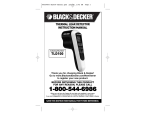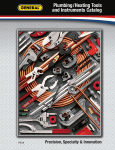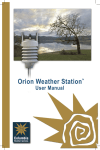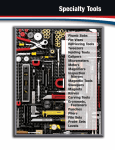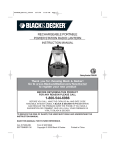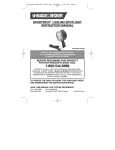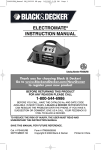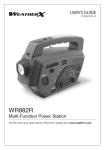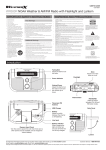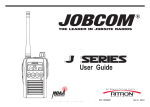Download Black & Decker 90527136 Instruction Manual
Transcript
WS100AB_ManualEN_SP_121107.qxp 12/11/2007 3:35 PM Page 16 Eliminación de la batería Contiene una batería recargable de Ni-MH, que debe eliminarse de manera correcta. Se requiere reciclado: comuníquese con su autoridad local para obtener información. El incumplimiento de las reglamentaciones locales, estatales y federales pueden provocar multas o penas de prisión. Para obtener más información sobre cómo reciclar esta batería, llame a la línea gratuita (800) 822-8837. ADVERTENCIAS No arroje la unidad al fuego, ya que las baterías internas del producto pueden explotar o tener filtraciones. No exponga la unidad que contiene la batería al fuego o a un calor intenso, porque puede explotar. Accesorios SPORT LANTERN/RADIO INSTRUCTION MANUAL Los accesorios que se recomiendan para la herramienta están disponibles en su distribuidor local o en el centro de mantenimiento autorizado. Si necesita asistencia en relación con los accesorios, llame al: 1-800-544-6986. ADVERTENCIA: El uso de accesorios no recomendados para utilizar con esta herramienta puede resultar peligroso. Información del servicio técnico Todos los Centros de mantenimiento de Black & Decker cuentan con personal capacitado dispuesto a brindar a los clientes un servicio eficiente y confiable en la reparación de herramientas eléctricas. Si necesita consejo técnico, reparaciones o piezas de repuesto originales de fábrica, póngase en contacto con el Centro de Servicio de Black & Decker más cercano a su domicilio. Para localizar su centro de mantenimiento local, consulte “Herramientas eléctricas” (Tools-Electric) en la sección de páginas amarillas, llame al 1-800-544-6986 o visite www.blackanddecker.com. PRECAUCIÓN: En caso de que cualquier tipo de cable se dañe, envíe la unidad completa al fabricante de inmediato para su mantenimiento o reparación. GARANTÍA COMPLETA DE DOS AÑOS PARA USO EN EL HOGAR Black & Decker (Estados Unidos) Inc. ofrece una garantía de dos años por cualquier defecto del material o de fabricación de este producto. El producto defectuoso se reparará o reemplazará sin costo alguno de dos maneras. La primera opción, el reemplazo, es devolver el producto al comercio donde se lo adquirió (siempre y cuando se trate de un comercio participante). Las devoluciones deben realizarse conforme a la política de devolución del comercio (generalmente, entre 30 y 90 días posteriores a la venta). Le pueden solicitar comprobante de compra. Consulte en el comercio acerca de la política especial sobre devoluciones una vez excedido el plazo establecido. La segunda opción es llevar o enviar el producto (con flete pago) a un Centro de mantenimiento autorizado o de propiedad de Black & Decker para su reparación o reemplazo según nuestro criterio. Le pueden solicitar comprobante de compra. Encontrará una lista de los Centros de mantenimiento autorizados y de propiedad de Black & Decker bajo "Herramientas eléctricas" (Tools-Electric) en las páginas amarillas de la guía telefónica y también en nuestro sitio Web www.blackanddecker.com. Esta garantía no se aplica a los accesorios. Esta garantía le concede derechos legales específicos; usted puede tener otros derechos que pueden variar según el estado o la provincia. Si tiene alguna pregunta, comuníquese con el gerente del Centro de mantenimiento de Black & Decker más cercano. Este producto no está diseñado para uso comercial. REEMPLAZO GRATUITO DE LAS ETIQUETAS DE ADVERTENCIA: Si las etiquetas de advertencia se tornan ilegibles o faltan, llame al 1-800-544-6986 para reemplazarlas gratuitamente. ESPECIFICACIONES Voltaje de funcionamiento: Estaciones de radio: Sensibilidad de la radio meteorológica: Altavoz: Bombilla de la linterna: Batería recargable de respaldo: Importado por Black & Decker (EE. UU.) Inc., 701 E. Joppa Rd. Towson, MD 21286 EE. UU. 12 voltios de CC AM: 530-1710 kHz FM: 88-108 MHz Clima 162.400, 162.425, 162.450, 162.475, 162.500, 162.525 y 162.550 MHz 0,6 µV a 12 dB SINAD 0,5 µV a 1050 Hz tono de alerta 8 ohms, 1 vatio 12 voltios, 5 vatios Ni-MH 3,6 V, 600 mAh Consulte las Páginas Amarillas para más información de servicio y ventas Catalog Number WS100AB Thank you for choosing Black & Decker! Go to www.BlackandDecker.com/NewOwner to register your new product BEFORE RETURNING THIS PRODUCT FOR ANY REASON PLEASE CALL 1-800-544-6986 BEFORE YOU CALL, HAVE THE CATALOG No, AND DATE CODE AVAILABLE. IN MOST CASES, A BLACK & DECKER REPRESENTATIVE CAN RESOLVE THE PROBLEM OVER THE PHONE. IF YOU HAVE A SUGGESTION OR COMMENT, GIVE US A CALL. YOUR FEEDBACK IS VITAL TO BLACK & DECKER. SAVE THIS MANUAL FOR FUTURE REFERENCE. Cat. # WS100AB December 2007 Form # 90527136 Copyright © 2007 Black & Decker RD121107 16 1 Printed in China WS100AB_ManualEN_SP_121107.qxp 12/11/2007 3:35 PM Page 2 GENERAL SAFETY WARNINGS AND INSTRUCTIONS FOR ALL APPLIANCES READ ALL INSTRUCTIONS WARNING: Read all instructions before operating product. Failure to follow all instructions listed below may result in electric shock, fire and/or serious injury. • AVOID DANGEROUS ENVIRONMENTS: Don’t use appliance in damp or wet locations. Don’t use appliances in the rain. • STORE IDLE APPLIANCES INDOORS. When not in use, appliance should be stored indoors in a dry place. • DON’T FORCE APPLIANCE. It will do the job better and with less likelihood of a risk of injury at the rate for which it was designed. • USE RIGHT APPLIANCE. Do not use the appliance for any job except that for which it is intended. • DON’T ABUSE CORD. Never carry appliance by cord or yank it to disconnect from receptacle. Keep cord from heat, oil, and sharp edges. • DON’T OVERREACH. Keep proper footing and balance at all times. • USE OF ACCESSORIES AND ATTACHMENTS. The use of any accessory or attachment not recommended for use with this appliance could be hazardous. Note: Refer to the accessory section of this manual for further details. • CHECK DAMAGED PARTS. Before further use of the appliance, a guard or other part that is damaged should be carefully checked to determine that it will operate properly and perform its intended function. Check for alignment of moving parts, binding of moving parts, breakage of parts, mounting, and any other conditions that may affect its operation. A guard or other part that is damaged should be properly repaired or replaced by an authorized service center unless otherwise indicated elsewhere in this instruction manual. Have defective switches replaced by authorized service center. Do not use appliance if switch does not turn it on and off. • DO NOT OPERATE portable electric appliances near flammable liquids or in gaseous or explosive atmospheres. Motors in these tools normally spark, and the sparks might ignite fumes. SAFETY GUIDELINES / DEFINITIONS DANGER: Indicates an imminently hazardous situation which, if not avoided, will result in death or serious injury. WARNING: Indicates a potentially hazardous situation which, if not avoided, could result in death or serious injury. CAUTION: Indicates a potentially hazardous situation which, if not avoided, may result in minor or moderate injury. CAUTION: Used without the safety alert symbol indicates potentially hazardous situation which, if not avoided, may result in property damage. RISK OF UNSAFE OPERATION. When using tools or equipment, basic safety precautions should always be followed to reduce the risk of personal injury. Improper operation, maintenance or modification of tools or equipment could result in serious injury and property damage. There are certain applications for which tools and equipment are designed. Black & Decker strongly recommends that this product NOT be modified and/or used for any application other than for which it was designed. Read and understand all warnings and operating instructions before using any tool or equipment. WEATHER RADIO SAFETY INSTRUCTIONS WARNING: This product should not be the only source of information for all-hazard, watches and warnings. If severe weather is imminent; do not wait to receive the weather alert warning, take precautionary measures to protect yourself. WARNING: The Weather Radio in this unit is designed to receive NOAA weather and other emergency alerts as listed in this manual and communicate these alerts to you. You may not receive or clearly hear these alerts under any of, but not limited to, the following circumstances: • Improper setup (Unit not in Alert Mode, or turned on): make sure that the unit is turned ON and the Alert LCD indicator is lit (see page 5 for Weather Radio instruction). • Volume is too low: adjust the volume to an audible level using the Volume Control Knob. • The internal batteries are dead: recharge the unit using the AC charging method. • Lost or poor reception, which can be attributed to any of the following: a) Improper antenna setup. To ensure you get the best available reception extend the built-in antenna and adjust its direction to provide maximum reception. b) Improper tuner setup. To ensure you are always tuned in to receive the NOAA alerts check the National Weather Service website at www.nws.noaa.gov/nwr/nwrbro for the signal frequency in your area. If you are 2 on the correct frequency and fail to get a signal, check that you have power and/or try placing the radio close to a window. c) Your location is out of range from a weather radio transmitter; the broadcast range from the weather radio transmitter is approximately 40 miles. The effective range depends on such things as terrain and quality of the receiver and indoor/outdoor antenna. Log onto http://www.nws.noaa.gov/nwr/nwrbro.htm to see which frequency best serves your area. d) Metal structure; to improve the radio’s ability to receive NOAA broadcast; do not place the unit near any large obstructions or metal surfaces such as refrigerators, metal cabinets, etc. In metal structures, such as mobile homes, reception is difficult because the metal structure impedes the transmission of monitor waves, in this case, place the radio close to a window to improve reception. e) Radio frequency interference; some electronics may cause radio frequency interference such as two-way radios, remote control cars, etc. Place the unit as far away as possible from these devices or avoid the usage of devices that cause radio frequency interference while the unit is in alert mode. f) The tuner has drifted off the weather channel station. • If there is excessive background noise while monitoring alerts; or when the alert comes on, adjust the volume using the Volume Control Knob or relocate the unit to a better location where you can hear the weather broadcast without risk of interference from background noise. • If you are out of audible range of or far away from the unit; or if there is an obstruction between you and the radio, be sure to check the unit for warnings periodically or remain close enough (within hearing range) to clearly hear and understand the alerts. WARNING: To ensure to continuously monitor alerts from NOAA while the unit is in alert mode, the unit should be checked periodically to confirm its functionality and for loss of reception; also check for loss of reception after moving the unit to a different location; also check for loss of reception after moving the unit to a different location or re-orienting the unit in its existing location. • Test Warnings from NOAA: All National Weather Services periodically transmit test signals. Some stations broadcast a test signal every week on Wednesday between 11 AM and 1 PM, while others test more often, the NWS may also broadcast System demonstrations. You can find out when your local NWS broadcasts test signals by calling the NOAA National Weather Service Forecast Office (listed under “Weather” in the Federal Government section of the telephone book.) During the weekly test signal, the local NWS will give a list of counties covered by their transmitter. IMPORTANT SAFETY INSTRUCTIONS WARNING: This product or its power cord contains lead, a chemical known to the State of California to cause cancer and birth defect or other reproductive harm. Wash hands after handling. WARNING: DO NOT disassemble the unit and NEVER attempt to operate the unit without the bulb and housing in place. Other than the 9 “C” size dry cell batteries, there are no user-replaceable parts. WARNING: TO REDUCE THE RISK OF ELECTRIC SHOCK: • Do not operate unit if it has received a sharp blow, been dropped, or otherwise damaged in any way. Do not disassemble the unit; take it to a qualified service technician when service or repair is required. Incorrect reassembly may result in a risk of electric shock or fire, and will void warranty. • Use of an attachment not supplied, recommended or sold by manufacturer specifically for use with this unit may result in a risk of electrical shock and injury to persons. • NEVER SUBMERGE THIS UNIT IN WATER; do not expose it to rain, snow or use when wet. CAUTION: TO REDUCE THE RISK OF INJURY OR PROPERTY DAMAGE: • All halogen lights give off heat: – Do not touch lens while operating. – Keep combustibles away from spotlight lens. Extreme heat can cause fires. – Never place the light face-down on any surface when lit. • Never look directly into the light or shine the light into another person’s eyes. • Keep sharp objects away from lens — it is glass and can break. • Do not immerse spotlight in water. • Do not drop or throw spotlight. It contains glass and a sealed lead acid battery. • Do not open the unit’s main body — there are no user-serviceable parts inside. • DO NOT expose to extreme heat or flames. 3 WS100AB_ManualEN_SP_121107.qxp 12/11/2007 3:35 PM Page 4 • Although this unit contains a non-spillable battery, it is recommended that unit be kept upright during storage, use and recharging. To avoid possible damage that may shorten the unit’s working life, protect it from direct sunlight, direct heat and/or moisture. • Check unit periodically for wear and tear. Take to a qualified technician for replacement of worn or defective parts immediately. WARNING: Batteries can explode, or leak, and can cause injury or fire. To reduce this risk: • Carefully follow all instructions and warnings on the battery label and package. • Always insert batteries correctly with regard to polarity (+ and –), marked on the battery and the equipment. • Do not short battery terminals. • Do not mix old and new batteries. Replace all of them at the same time with new batteries of the same brand and type. • Immediately remove batteries that will not hold a charge and dispose of per local codes. • Do not dispose of batteries in fire. • Keep batteries out of reach of children. “Transporting batteries can possibly cause fires if the battery terminals inadvertently come in contact with conductive materials such as keys, coins, hand tools and the like. The US Department of Transportation Hazardous Material Regulations (HMR) actually prohibit transporting batteries in commerce or on airplanes (i.e. packed in suitcases and carryon luggage) UNLESS they are properly protected from short circuits. So when transporting individual batteries, make sure that the battery terminals are protected and well insulated from materials that could contact them and cause a short circuit.” CAUTION: TO REDUCE THE RISK OF DAMAGE TO THE UNIT: • Although this unit contains a non-spillable battery, it is recommended that unit be kept upright during storage, use and recharging. To avoid possible damage that may shorten the unit’s working life, protect it from direct sunlight, direct heat and/or moisture. • Read And Understand This Instruction Manual Before Using This Unit. SAVE THESE INSTRUCTIONS This device complies with part 15 of the FCC rules. Operation is subject to the following two conditions: (1) this device may not cause harmful interference, and (2) this device must accept any interference received, including interference that may cause undesired operation. This equipment has been tested and found to comply with the limits for a Class B digital device, pursuant to part 15 of the FCC Rules. These limits are designed to provide reasonable protection against harmful interference in a residential installation. This equipment generates, uses and can radiate radio frequency energy and, if not installed and used in accordance with the instructions, may cause harmful interference to radio communications. However, there is no guarantee that interference will not occur in a particular installation. If equipment does cause harmful interference to radio or television reception, which can be determined by turning the equipment off and on, the user is encouraged to try to correct the interference by one or more of the following measures: • Reorient or relocate the receiving antenna. • Increase the separation between equipment and receiver. • Connect the equipment into an outlet on a circuit different from that to which the receiver is connected. • Consult the dealer or an experienced radio/TV technician for help. INTRODUCTION Thank you for choosing the Black & Decker® Sport Lantern/Radio, Model WS100AB. Please read this guide carefully before use to ensure optimum performance and avoid damage to the unit. FEATURES • • • • • • • • • AM/FM Weather Alert Radio with automatic hazard alert Powerful quartz halogen Lantern Long-lasting 3-LED Emergency Light Cell Phone Charging Port* and charging tips (included) Built-in Earphone Jack (earphone not included) Built-in Telescoping Antenna for enhanced reception Battery powered using nine (9) standard “C” dry cell batteries Built-in Rechargeable Backup Battery for auxiliary power with Fold-Away Hand-Crank for recharging Rubber Grip Carry Handle *May not work with all cell phones. 4 Power System This unit has a unique power system. Its primary power source is the standard “C” dry cell battery. This unit also comes with a built-in Ni-MH Rechargeable Backup Battery, that serves as “auxiliary” power for the AM/FM Weather Alert Radio and LED Emergency Light should no other power source be available. This auxiliary power system may be recharged using the Fold-Away Hand Crank. Note: Backup battery power will only operate the Radio and LED Emergency Light. IT CANNOT POWER THE LANTERN. Controls and Functions 9 8 7 6 5 1 2 3 4 10 18 11 17 12 16 13 15 14 1. Quartz Halogen Lantern 2. Volume Control Dial 3. Radio Frequency Indicator 4. Radio Tuning Knob 5. Alarm Lock Pushbutton 6. OFF/AM/FM/Weather Band Selector 7. Alert ON/OFF Pushbutton 8. Rubber Grip Carry Handle 9. Lantern ON/OFF Locking Trigger Switch 10. LED Emergency Light ON/OFF Pushbutton 11. 3 LED Emergency Light 12. Charging LED 13. Power Selector Switch 14. Cell Phone Charging Port 15. Earphone Jack 16. Fold-Away Hand-Crank to recharge backup battery 17. Mono speaker 18. Telecscoping Antenna POWERING THE UNIT The unit can be powered in one of two ways: 1. With nine (9) standard dry cell “C” batteries (not included). 2. Using the internal backup Ni-MH battery. The backup battery allows the Radio and Emergency Light to operate when the “C” batteries are expended and replacements are not available. The rechargeable backup battery is not user-accessible. 5 WS100AB_ManualEN_SP_121107.qxp 12/11/2007 3:35 PM Page 6 Using Dry Cell Battery Power OPERATING THE LANTERN • Open the battery cover and insert nine (9) “C” dry cell batteries. • Slide the Power Selector Switch on the back of the unit to the “Dry Battery” position. • Test by turning the Lantern ON before proceeding to general operation. CAUTIONS When replacing the “C” dry cell batteries: • DO NOT mix old and new batteries. • DO NOT mix alkaline, standard (carbon-zinc) and rechargeable (nickel cadmium) batteries. • Refer to the additional batteries warnings and cautions found in the “Important Safety Instructions” section on page 3 of this Instruction Manual. The Lantern is controlled by the On/Off Locking Trigger Switch (see the “Controls and Functions” section on page 5 to locate). Make sure the Lantern is turned OFF when recharging the internal backup battery and when the unit is being stored. Using Internal Backup Battery Power • Slide the Power Selector Switch on the back of the unit to the “Ni-MH Battery” position. • Test by turning the LED Emergency Light ON before proceeding to general operation. Recharging the Internal Backup Battery Using the Fold-Away Hand-Crank Pull the Fold-Away Hand-Crank out so it is adjacent to the unit body. Rotate the Hand-Crank handle (at a rate of 12 rotations per second, with all functions OFF for best results) to generate power if backup battery power is low. The green Charging LED on the back of the unit will light. Note: Backup power operates the LED Emergency Light, Radio and Cell Phone Charging Port only. The Lantern will not operate from backup power; it can only be powered by the replaceable “C” dry cell batteries. OPERATING THE AM/FM/WEATHER RADIO Refer to the “Controls and Functions” illustrations on page 5 to locate referenced controls. • Slide the OFF/AM/FM/WEATHER Band Selector to the desired frequency. • Turn the Radio Tuning Knob to tune in the desired station. • Extend the Telescoping Antenna and adjust for best reception. • Turn the Volume Control Dial to adjust radio volume. • Insert earphones/headphones (not supplied) into the Earphone Jack if private listening is desired. SETTING THE UNIT TO RECEIVE WEATHER ALERTS Refer to the “Controls and Functions” illustrations on page 5 to locate referenced controls. • Slide the OFF/AM/FM/WEATHER Band Selector to the WEATHER position. • Turn the Radio Tuning Knob to tune in the NOAA station with the clearest signal. • Extend the Telescoping Antenna and adjust for best reception. • Turn the Volume Control Dial to adjust radio volume. • Press the Alert ON/OFF Pushbutton to turn Weather Alert ON. • If desired, press the Alarm Lock ON/OFF Pushbutton. In ALERT mode, the hazard alarm will sound briefly when a hazard alert is received. In LOCK mode, the alarm sounds continuously when a hazard alert is received. Alert works only when the OFF/AM/FM/WEATHER Band Selector is in the WEATHER position and a NOAA station has been tuned in using the Radio Tuning Knob. NOAA Weather Radio (NWR) All Hazards NWR is an all-hazards public warning system, broadcasting forecast, warning and emergency information 24 hours a day directly to the public. 7 NWR Broadcast Frequencies include: 162.400MHz, 162.425 MHz, 162.450 MHz, 162.475 MHz, 162.500 MHz, 162.525 MHz, 162.550MHz. Broadcast range from the weather radio transmitter is approximately 40 miles. The effective range depends on such things as terrain and quality of the receiver and indoor/outdoor antenna. Log onto http://www.nws.noaa.gov/nwr/nwrbro.htm to see which frequency best serves your area. “All-Hazard” messages are: • Weather emergencies • Forest fires • Train derailment • Tornados • Avalanches • National emergencies • Hurricanes • Technological emergencies • Homeland security warnings • Floods • Chemical & biological hazard • Terrorists attacks • Blizzards • Oil spill • Civil emergencies • Natural emergencies • Nuclear power plant emergencies • Amber alerts • Earthquakes • Maritime accidents 6 OPERATING THE 3-LED EMERGENCY LIGHT The 3-LED Emergency Light is controlled by the LED Emergency Light ON/OFF Pushbutton (see the “Controls and Functions” section on page 5 to locate). Press it once to turn the LED Emergency Light ON; and again to turn it OFF. USING THE CELL PHONE CHARGING PORT The unit does not need to be turned ON in order to use the Cell Phone Charging function. CELL PHONES CAN BE RECHARGED USING THE INTERNAL BACKUP BATTERY HANDCRANK ONLY. • Slide the Power Selector Switch on the back of the unit to the “Ni-MH Battery” position. • Attach the appropriate charging tip (from among those supplied, shown to the right) to the small barrel tip of the Cell Phone Charging Adapter cord and plug this into the cell phone. • Plug the barrel tip end of the cord into the Cell Phone Charging Port (see the “Controls and Functions” section on page 5 to locate). • Pull the Fold-Away Hand-Crank out so it is adjacent to the unit body and rotate the Hand-Crank handle. • The green Charging LED on the back of the unit will light. CAUTION SUPPLIED CELL PHONE CHARGING TIPS MAY NOT WORK WITH ALL CELL PHONES. Using the wrong tip may damage your device. Manufacturer is not responsible for damage caused in this manner. Verify tip compatibility with your cell phone manufacturer or consult your cell phone user manual before using this unit's cell phone charging feature. TROUBLESHOOTING General Problem The unit will not power ON. Lantern and/or LED Emergency Light will not function. Solution Battery power is low. Either change the dry cell batteries or recharge the built-in Backup Battery. Radio Problem Receptions is poor Audio is week or has poor quality. Solution Reorient the antenna to improve reception. Battery power is low. Either change the dry cell batteries or recharge the built-in Backup Battery. CARE AND MAINTENANCE Internal Backup Battery Replacement It is recommended that the unit be returned to manufacturer for battery replacement. Contact Customer Service, toll-free, at 1-800-544-6986. Battery Disposal Contains a rechargeable Ni-MH battery, which must be disposed of properly. Recycling is required — contact your local authority for information. Failure to comply with local, state and federal regulations can result in fines or imprisonment. For more information on recycling this battery, call toll-free (800) 822-8837. WARNINGS Do not dispose of this unit in fire as batteries inside this product may explode or leak. Do not expose the unit containing a battery to fire or intense heat as it may explode. 7 WS100AB_ManualEN_SP_121107.qxp 12/11/2007 3:35 PM Page 8 Accessories Recommended accessories for use with your tool are available from your local dealer or authorized service center. If you need assistance regarding accessories, please call: 1-800-544-6986. WARNING: The use of any accessory not recommended for use with this tool could be hazardous. Service Information All Black & Decker Service Centers are staffed with trained personnel to provide customers with efficient and reliable power tool service. Whether you need technical advice, repair, or genuine factory replacement parts, contact the Black & Decker location nearest you. To find your local service location, refer to the yellow page directory under "Tools—Electric" or call: 1-800-544-6986 or visit www.blackanddecker.com. CAUTION If the cord, wires, or cables become damaged, return the entire unit to manufacturer immediately for service/repair. MANUAL DE INSTRUCCIONES DE LA RADIO DEPORTIVA CON LINTERNA FULL TWO-YEAR HOME USE WARRANTY Black & Decker (U.S.) Inc. warrants this product for two years against any defects in material or workmanship. The defective product will be replaced or repaired at no charge in either of two ways. The first, which will result in exchanges only, is to return the product to the retailer from whom it was purchased (provided that the store is a participating retailer). Returns should be made within the time period of the retailer’s policy for exchanges (usually 30 to 90 days after the sale). Proof of purchase may be required. Please check with the retailer for their specific return policy regarding returns that are beyond the time set for exchanges. The second option is to take or send the product (prepaid) to a Black & Decker owned or authorized Service Center for repair or replacement at our option. Proof of purchase may be required. Black & Decker owned and authorized Service Centers are listed under "Tools-Electric" in the yellow pages of the phone directory and on our website www.blackanddecker.com. This warranty does not apply to accessories. This warranty gives you specific legal rights and you may have other rights which vary from state to state or province to province. Should you have any questions, contact the manager of your nearest Black & Decker Service Center. This product is not intended for commercial use. FREE WARNING LABEL REPLACEMENT: If your warning labels become illegible or are missing, call 1-800-544-6986 for a free replacement. SPECIFICATIONS Operating Voltage: Radio Stations: Weather Radio Sensitivity: Speaker: Lantern Bulb: Rechargeable Backup Battery: Imported by Black & Decker (U.S.) Inc., 701 E. Joppa Rd. Towson, MD 21286 U.S.A. 12 volt DC AM: 530-1710 kHz FM: 88-108 MHz Weather: 162.400, 162.425, 162.450, 162.475, 162.500, 162.525, and 162.550 MHz 0.6µV@12dB SINAD 0.5µV@1050 Hz alert tone 8 ohm, 1W 12v 5 watt Ni-MH 3.6V, 600 mAh RD121107 Número de catálogo WS100AB ¡Gracias por elegir Black & Decker! Vaya a www.BlackandDecker.com/NewOwner para registrar su nuevo producto. ANTES DE DEVOLVER ESTE PRODUCTO POR CUALQUIER MOTIVO, LLAME AL 1-800-544-6986 ANTES DE LLAMAR, TENGA A MANO EL N.º DE CATÁLOGO Y EL CÓDIGO DE LA FECHA. EN LA MAYORÍA DE LOS CASOS, UN REPRESENTANTE DE BLACK & DECKER PODRÁ SOLUCIONAR SU PROBLEMA POR TELÉFONO. SI DESEA REALIZAR UNA SUGERENCIA O COMENTARIO, LLÁMENOS, SU OPINIÓN ES FUNDAMENTAL PARA BLACK & DECKER. CONSERVE ESTE MANUAL PARA FUTURAS CONSULTAS. N.º de catálogo WS100AB N.º de formulario 90527136 Deciembre 2007 Copyright © 2007 Black & Decker 8 9 Impreso en China WS100AB_ManualEN_SP_121107.qxp 12/11/2007 3:35 PM Page 10 INSTRUCCIONES GENERALES Y ADVERTENCIAS DE SEGURIDAD PARA TODOS LOS ARTEFACTOS LEA TODAS LAS INSTRUCCIONES ADVERTENCIA: Lea todas las instrucciones antes de hacer funcionar el producto. El incumplimiento de todas las instrucciones enumeradas a continuación puede provocar una descarga eléctrica, un incendio o lesiones graves. • EVITE LAS CONDICIONES AMBIENTALES PELIGROSAS. No utilice artefactos en zonas húmedas o mojadas. No utilice artefactos bajo la lluvia. • GUARDE LOS ARTEFACTOS QUE NO UTILICE EN EL INTERIOR. Cuando no lo utilice, el aparato debe guardarse en interiores, en un lugar seco. • NO FUERCE EL APARATO. Funcionará mejor y con menos probabilidades de daños si se opera a la velocidad para la que fue diseñada. • UTILICE EL APARATO ADECUADO. Nunca utilice el aparato para otra tarea que no sea aquella para la que fue creado. • NO TIRE DEL CABLE. Nunca transporte el aparato por el cable ni lo jale para desconectarlo del tomacorriente. Mantenga el cable alejado del calor, el aceite y los bordes afilados. • NO SE ESTIRE. Conserve el equilibrio y párese adecuadamente en todo momento. • USO DE SUPLEMENTOS Y ACCESORIOS. El uso de accesorios o dispositivos no recomendados para utilizar con este aparato puede resultar peligroso. Nota: Consulte la sección “Accesorios” de este manual para obtener detalles adicionales. • VERIFIQUE QUE NO HAYA PIEZAS DAÑADAS. Antes de volver a utilizar el aparato, se debe controlar cualquier protección u otra pieza que esté averiada para determinar si funcionará correctamente y realizará la función para la que fue diseñada. Verifique la alineación y la sujeción de las piezas móviles, la rotura de piezas, el montaje y cualquier otra condición que pueda afectar su operación. Cualquier protección u otra pieza que esté dañada debe ser reparada correctamente o reemplazada por un centro de mantenimiento autorizado, a menos que este manual de instrucciones indique otra cosa. Reemplace los interruptores defectuosos en un centro de mantenimiento autorizado. No utilice la herramienta si no puede encenderla o apagarla con el interruptor. • NO OPERE herramientas eléctricas portátiles cerca de líquidos inflamables o en atmósferas gaseosas o explosivas. Los motores de estas herramientas normalmente chispean, y las chispas pueden encender los vapores. NORMAS DE SEGURIDAD/DEFINICIONES PELIGRO: Indica una situación de peligro inminente que, si no se evita, provocará la muerte o lesiones graves. ADVERTENCIA: Indica una situación de peligro potencial que, si no se evita, podría provocar la muerte o lesiones graves. PRECAUCIÓN: Indica una situación de peligro potencial que, si no se evita, puede provocar lesiones leves o moderadas. PRECAUCIÓN: Utilizado sin el símbolo de alerta de seguridad indica una situación de peligro potencial que, si no se evita, puede provocar daños en la propiedad. RIESGO DE OPERACIÓN INSEGURA. Cuando se utilizan herramientas o equipos, siempre se deben respetar las precauciones de seguridad para reducir el riesgo de lesiones personales. La operación, la modificación o el mantenimiento incorrectos de herramientas o equipos pueden provocar lesiones graves y daños a la propiedad. Las herramientas y los equipos están diseñados para determinados usos. Black & Decker recomienda enfáticamente que NO se modifique este producto y que NO se utilice para ningún otro uso que aquél para el que fue diseñado. Lea y comprenda todas las instrucciones operativas y las advertencias antes de utilizar cualquier herramienta o equipo. INSTRUCCIONES DE SEGURIDAD DE LA RADIO METEOROLÓGICA ADVERTENCIA: Este producto no debe ser la única fuente de información de las transmisiones de todo tipo de peligros, de alertas y advertencias. Si un clima riguroso es inminente, no espere a recibir la advertencia de alerta meteorológica, tome precauciones para protegerse. ADVERTENCIA: La radio meteorológica de esta unidad está diseñada para recibir alertas meteorológicas de la Oficina Nacional de Administración Oceánica y Atmosférica (NOAA) y otras alertas enumeradas en este manual y para comunicarle dichas alertas. Puede que no reciba o escuche con claridad estas alertas en las siguientes situaciones, entre otras: • Configuración incorrecta (la unidad no se encuentra en el modo de alerta o no está encendida); asegúrese de que la unidad esté encendida y que el indicador LED de alerta esté prendido (consulte la página 5 para obtener instrucciones sobre la radio meteorológica). • El volumen está demasiado bajo; regule el volumen a un nivel audible con la perilla de control de volumen. 10 • Las baterías internas están agotadas: recargue la unidad según el método de carga de CA. • La mala recepción o la pérdida de ésta pueden suceder por lo siguiente: a) Colocación incorrecta de la antena. Para obtener la mejor recepción disponible, extienda la antena incorporada y regule la dirección para conseguir la máxima recepción. b) Configuración incorrecta del sintonizador. Para asegurarse de que siempre está en sintonía para recibir las alertas de NOAA, visite el sitio Web del Servicio Nacional de Meteorología www.nws.noaa.gov/nwr/nwrbro para saber cuál es la señal de frecuencia en su área. Si está en la frecuencia correcta y no tiene señal, verifique que tenga corriente eléctrica o trate de colocar la radio cerca de una ventana. c) Su ubicación está fuera del alcance de una transmisora de radio meteorológica; el alcance de la transmisora de radio meteorológica es de aproximadamente 64 km (40 millas). El alcance efectivo depende de factores como el terreno y la calidad del receptor y de la antena interior y exterior. Para ver cuál es la frecuencia que mejor funciona en su área, ingrese a http://www.nws.noaa.gov/nwr/nwrbro.htm. d) Estructura metálica; para mejorar la capacidad de la radio para recibir la transmisión de la NOAA, no coloque la unidad cerca de grandes obstrucciones o superficies metálicas como refrigeradores, gabinetes metálicos, etc. En las estructuras metálicas, como casas rodantes, la recepción se dificulta porque la estructura metálica impide la transmisión de ondas receptoras; en este caso, coloque la radio cerca de una ventana para mejorar la recepción. e) Interferencia en la radiofrecuencia; algunos aparatos electrónicos, como los transceptores, los automóviles a control remoto, etc., pueden producir interferencia en la radiofrecuencia. Coloque la unidad tan lejos como sea posible de estos dispositivos o evite el uso de dispositivos que producen dicha interferencia mientras la unidad está en el modo de alerta. f) El sintonizador se ha desviado de la estación meteorológica. • Si hay demasiado ruido de fondo mientras recibe las alertas o cuando llega la alerta, regule el volumen con la perilla de control del volumen o cambie de lugar la unidad a una ubicación mejor donde pueda escuchar la transmisión meteorológica sin riesgo de interferencia del ruido de fondo. • Si está fuera del alcance de audición o lejos de la unidad, o si hay una obstrucción entre usted y la radio, controle la unidad en intervalos regulares por posibles advertencias o permanezca lo suficientemente cerca (dentro del alcance de audición) para escuchar con claridad y comprender las alertas. ADVERTENCIA: Para controlar las alertas de NOAA constantemente, mientras la unidad está en el modo de alerta, la unidad debe verificarse regularmente para confirmar su funcionamiento y también que no haya pérdida de la recepción; también controle la pérdida de recepción después de trasladar la unidad a un lugar diferente o de cambiarle la orientación en el lugar actual. • Las advertencias de prueba de NOAA; todos los servicios nacionales de meteorología transmiten señales de prueba con regularidad. Algunas estaciones transmiten una señal de prueba cada semana los miércoles entre las 11 a.m. y la 1 p.m., mientras que otras realizan pruebas más a menudo; el Servicio Nacional de Meteorología (NWS) también puede transmitir demostraciones del sistema. Puede averiguar cuando su NWS local transmite señales de prueba llamando a la Oficina de Pronósticos del Servicio Nacional de Meteorología del NOAA (que encuentra bajo “Weather” [meteorología] en la sección del Gobierno Federal de la guía telefónica). Durante la señal de prueba semanal, el NWS local dará la lista de condados cubiertos por su transmisora. INSTRUCCIONES IMPORTANTES SOBRE SEGURIDAD ADVERTENCIA: Este producto o su cable de alimentación contiene plomo, una sustancia química reconocida por el Estado de California como causante de cáncer, defectos de nacimiento u otros problemas reproductivos. Lávese las manos después de utilizarlo. ADVERTENCIA: No desarme la unidad y NUNCA intente operarla sin la bombilla o la cubierta en su lugar. Además de las 9 baterías secas tipo “C”, no hay piezas que pueda reemplazar el usuario. ADVERTENCIA: PARA REDUCIR EL RIESGO DE DESCARGA ELÉCTRICA: • No opere la unidad si ésta ha recibido un golpe fuerte, se cayó o presenta algún daño. No desarme la unidad; llévela a un técnico de servicio calificado cuando se requiera mantenimiento o una reparación. Volver a armarla de manera incorrecta podría provocar un riesgo de descarga eléctrica o un incendio, y anulará la garantía. • El uso de un dispositivo no suministrado, recomendado o vendido por el fabricante específicamente para el uso con esta unidad puede provocar riesgo de descarga eléctrica y lesiones a las personas. • NUNCA sumerja esta unidad en agua; no la exponga a la lluvia, la nieve, ni la use cuando esté mojada. PRECAUCIÓN: PARA REDUCIR EL RIESGO DE LESIONES O DAÑO A LA PROPIEDAD: • Todas las luces halógenas generan calor: – No toque la lente mientras está en funcionamiento. – Mantenga los combustibles lejos de la lente del faro buscahuella. El calor extremo puede provocar incendios. – Nunca coloque la luz hacia abajo sobre cualquier superficie cuando esté encendida. • Nunca mire directamente la luz ni alumbre en dirección a los ojos de otra persona. 11 WS100AB_ManualEN_SP_121107.qxp 12/11/2007 3:35 PM Page 12 • • • • • • Mantenga los objetos filosos alejados de la lente, ya que es de vidrio y se puede romper. No sumerja el faro buscahuella en agua. No arroje ni tire el faro buscahuella. Contiene vidrio y una batería de plomo ácido sellada. No abra el cuerpo principal de la unidad: no hay piezas que el usuario pueda reparar en su interior. NO lo exponga al calor extremo o a las llamas. Si bien esta unidad contiene una batería que no derrama, se recomienda que la unidad se conserve parada durante el almacenamiento, el uso y la recarga. Para evitar daños posibles que puedan acortar la duración de la unidad, protéjala de la luz solar directa, el calor directo o la humedad. • Controle el desgaste de la unidad periódicamente. Lleve la unidad a un técnico calificado para reemplazar las piezas desgastadas o defectuosas de inmediato. ADVERTENCIA: Las baterías pueden explotar o tener pérdidas y pueden provocar lesiones o incendios. Para disminuir este riesgo: • Siga cuidadosamente todas las instrucciones y las advertencias de la etiqueta y el envase de la batería. • Introduzca siempre las baterías correctamente respetando la polaridad (+ y -) indicada en la batería y en el equipo. • No produzca un cortocircuito con los terminales de la batería. • No mezcle baterías nuevas y viejas. Reemplácelas todas al mismo tiempo por baterías nuevas de la misma marca y tipo. • Quite de inmediato las baterías que no retengan la carga y elimínelas de acuerdo con los códigos locales. • No arroje las baterías al fuego. • Mantenga las baterías fuera del alcance de los niños. “Transportar baterías puede provocar incendios si los terminales de la batería entran en contacto accidentalmente con materiales conductores como llaves, monedas, herramientas de mano u objetos similares. De hecho, las Normas para Materiales Peligrosos del Departamento de Transporte de Estados Unidos (HMR) en realidad prohíben transportar baterías comercialmente o en aeroplanos (es decir, empacadas en valijas y equipaje de mano) A MENOS que estén protegidas correctamente de cortocircuitos. Por lo tanto, cuando transporte baterías individuales, asegúrese de que los terminales de la batería estén protegidos y bien aislados de materiales que puedan hacer contacto y causar un cortocircuito.” PRECAUCIÓN: PARA EVITAR DAÑOS A LA UNIDAD: • Si bien esta unidad contiene una batería que no derrama, se recomienda que la unidad se conserve parada durante el almacenamiento, el uso y la recarga. Para evitar daños posibles que puedan acortar la duración de la unidad, protéjala de la luz solar directa, el calor directo o la humedad. • Lea y comprenda este manual de instrucciones antes de utilizar esta unidad. • Accionamiento a batería, con nueve (9) baterías secas estándar tipo “C” • Batería recargable de respaldo incorporada, con manivela plegable para la recarga • Mango para trasladar con cubierta de goma *Puede no funcionar con todos los teléfonos celulares. Sistema de energía Esta unidad tiene un sistema de energía único. Su fuente de energía primaria es la batería seca estándar tipo “C”. Esta unidad también viene con una batería recargable de Ni-MH incorporada, que sirve como energía “auxiliar” para la radio de alerta meteorológica AM/FM y la luz de emergencia de LED, en caso de no contar con otra fuente de energía. Este sistema de energía auxiliar puede recargarse con la manivela plegable. Nota: La energía de la batería de respaldo sólo accionará la radio y la luz de emergencia de LED. No puede accionar la linterna. INTRODUCCIÓN Gracias por elegir la Radio deportiva con linterna Black & Decker®, Modelo WS100AB. Lea esta guía con detenimiento antes de utilizarla para garantizar su óptimo rendimiento y evitar daños a la unidad. CARACTERÍSTICAS • • • • • • Radio de alerta meteorológica AM/FM con alerta automática de peligros Linterna potente de cuarzo halógeno Luz de emergencia de 3 LED de larga duración Puerto de carga para teléfonos celulares* y puntas de carga (incluidas) Entrada incorporada para audífonos (no incluidos) Antena telescópica incorporada para una mejor recepción 12 7 6 5 1 2 3 4 10 18 11 CONSERVE ESTAS INSTRUCCIONES Este dispositivo cumple con la parte 15 de las normas de la Comisión Federal de Comunicaciones de Estados Unidos (FCC). La operación está sujeta a las dos condiciones siguientes: (1) este dispositivo no puede causar interferencia perjudicial y (2) este mecanismo debe aceptar cualquier interferencia recibida, incluida la interferencia que puede provocar una operación no deseada. Este equipo ha sido probado y se encontró que cumple con los límites para dispositivo digital Clase B, según la parte 15 de las normas de la FCC. Estos límites están diseñados para brindar protección razonable contra interferencia perjudicial en una instalación residencial. Este equipo genera, usa y puede irradiar energía en frecuencia de radio y, si no se instala y se usa de acuerdo con las instrucciones, puede provocar interferencia perjudicial en las comunicaciones de radio. Sin embargo, no hay garantía de que la interferencia no ocurra en una instalación en particular. Si el equipo provoca interferencia perjudicial en la recepción de radio o televisión, lo que se puede determinar al apagar y encender el equipo, el usuario debe tratar de corregir la interferencia mediante una o más de las siguientes medidas: • Cambiar la orientación o la ubicación de la antena de recepción. • Aumentar la separación entre el equipo y el receptor. • Conectar el equipo a un tomacorriente sobre un circuito diferente de aquel al que está conectado el receptor. • Consultar al vendedor o pedir la ayuda de un técnico en radio y televisión con experiencia. 9 8 Controles y funciones 17 12 16 13 15 1. 2. 3. 4. 5. 6. 7. Linterna de cuarzo halógeno Dial de control de volumen Indicador de radiofrecuencia Perilla de sintonización de radio Botón de bloqueo de alarma Selector de bandas “OFF/AM/FM/Weather” Botón de encendido/apagado (ON/OFF) de alertas 8. Mango para trasladar con cubierta de goma 9. Interruptor de encendido/apagado (ON/OFF) de la linterna con interruptor disparador de bloqueo 14 10. Botón de encendido/apagado (ON/OFF) de la luz de emergencia de LED 11. Luz de emergencia de 3 LED 12. LED de carga 13. Interruptor selector de energía 14. Puerto de carga para teléfonos celulares 15. Entrada de audífonos 16. Manivela plegable para recargar la batería de respaldo 17. Altavoz mono 18. Antena telescópica ACCIONAMIENTO DE LA UNIDAD La unidad puede accionarse de dos maneras: 1. Con las nueve (9) baterías secas estándar tipo “C” (no incluidas). 2. Con la batería de Ni-MH de emergencia interna. 13 WS100AB_ManualEN_SP_121107.qxp 12/11/2007 3:35 PM Page 14 La batería de respaldo permite que la radio y la luz de emergencia funcionen cuando las baterías tipo “C” están gastadas y no hay repuestos. La batería recargable de emergencia no es accesible al usuario. Uso de las baterías secas • Abra la cubierta de las baterías e inserte nueve (9) baterías secas tipo “C”. • Deslice el interruptor selector de energía en la parte posterior de la unidad a la posición “Dry battery” (batería seca). • Pruebe encender la linterna antes de continuar con la operación general. PRECAUCIONES Cuando reemplace las baterías secas tipo “C”: • NO mezcle baterías nuevas y viejas. • NO mezcle baterías alcalinas, estándar (carbono-zinc) y baterías recargables (níquel-cadmio). • Consulte las advertencias y precauciones adicionales sobre baterías que se encuentran en la sección “Instrucciones de seguridad importantes”, en la página 3 de este manual de instrucciones. Uso de la batería interna de respaldo • Deslice el interruptor selector de energía, que se encuentra en la parte posterior de la unidad, a la posición “Dry battery”. • Pruebe ENCENDER la luz de emergencia LED antes de continuar con la operación general. Recarga de la batería interna de respaldo con la manivela plegable Despliegue la manivela plegable de manera que quede adyacente al cuerpo de la unidad. Gire el mango de la manivela (a una velocidad de 1 a 2 rotaciones por segundo, con todas las funciones apagadas para obtener mejores resultados) a fin de generar energía, en caso de que la energía de la batería de respaldo esté baja. Se encenderá el LED de carga verde en la parte posterior de la unidad. Nota: La energía de respaldo acciona sólo la luz de emergencia de LED, la radio y el puerto de carga para teléfonos celulares. La linterna no funcionará con la energía de emergencia; solo puede funcionar con las baterías secas reemplazables tipo “C”. FUNCIONAMIENTO DE LA RADIO METEOROLÓGICA AM/FM Consulte las ilustraciones “Controles y funciones” de la página 13 para ubicar los controles mencionados. • Deslice el selector de banda “OFF/AM/FM/WEATHER” a la frecuencia deseada. • Gire la perilla de sintonización de radio a la estación deseada. • Prolongue la antena telescópica y ajústela para una mejor recepción. • Gire el control del volumen para ajustar el volumen de la radio. • Inserte audífonos o auriculares (no incluidos) en la entrada de audífonos para escuchar de forma privada. CONFIGURACIÓN DE LA UNIDAD PARA RECIBIR ALERTAS METEOROLÓGICAS Consulte las ilustraciones “Controles y funciones” de la página 13 para ubicar los controles mencionados. • Deslice el selector de banda “OFF/AM/FM/WEATHER” a la posición “WEATHER” (clima). • Gire la perilla de sintonización de radio para sintonizar la estación NOAA con la señal más clara. • Prolongue la antena telescópica y ajústela para una mejor recepción. • Gire el control del volumen para ajustar el volumen de la radio. • Presione el botón “Alert ON/OFF” (alerta encendido/apagado) para accionar la alerta meteorológica. • Si lo desea, presione el botón “Alarm Lock ON/OFF”. En el modo “Alert”, la alarma de peligros sonará brevemente cuando se reciba una alerta de peligro. En el modo “LOCK”, la alarma suena de forma continua cuando se recibe una alerta de peligro. La alerta funciona sólo cuando el selector de banda “OFF/AM/FM/WEATHER” está en la posición “WEATHER” y se sintonizó una estación NOAA con la perilla de sintonización de radio. RADIO METEOROLÓGICA NOAA (NWR) DE TODO TIPO DE PELIGRO NWR es un sistema de advertencia pública contra todo tipo de peligro; transmite pronósticos, advertencias e información de emergencia las 24 horas del día directamente al público. Las 7 frecuencias de transmisión de la NWR incluyen: 162.400 MHz, 162.425 MHz, 162.450 MHz, 162.475 MHz, 162 500 MHz, 162.525 MHz, 162.550 MHz. El alcance de la transmisora de radio meteorológica es de aproximadamente 64 km (40 millas). El alcance efectivo depende de factores como el terreno y la calidad del receptor y de la antena interior o exterior. Para ver cuál es la frecuencia que mejor funciona en su área, ingrese a http://www.nws.noaa.gov/nwr/nwrbro.htm. 14 Los mensajes de “Todo tipo de peligro” son: • Emergencias meteorológicas • Avalanchas • Tornados • Emergencias tecnológicas • Huracanes • Peligros químicos y biológicos • Inundaciones • Derrames de petróleo • Tormentas de nieve • Emergencias en plantas de • Emergencias naturales energía nuclear • Terremotos • Accidentes marítimos • Incendios forestales • Descarrilamiento de trenes • Emergencias nacionales • Advertencias del Departamento de Seguridad Nacional • Ataques terroristas • Emergencias civiles • Alertas AMBER FUNCIONAMIENTO DE LA LINTERNA La linterna se controla con el interruptor de encendido/apagado (ON/OFF) con disparador de bloqueo (consulte la sección “Controles y funciones” en la página 4 para ubicarlo). Asegúrese de que la linterna esté apagada (OFF) cuando recargue la batería de emergencia interna y cuando almacene la unidad. FUNCIONAMIENTO DE LA LUZ DE EMERGENCIA DE 3 LED La luz de emergencia de 3 LED se controla mediante el botón de encendido/apagado (ON/OFF) de la luz de emergencia LED (consulte la sección “Controles y funciones” en la página 4 para ubicarlo). Presiónelo una vez para ENCENDER la luz de emergencia LED y una vez más para APAGARLA. USO DEL PUERTO DE CARGA PARA TELÉFONOS CELULARES La unidad no necesita ENCENDERSE para utilizar la función de carga del teléfono. LOS TELÉFONOS CELULARES SÓLO PUEDEN RECARGARSE CON LA MANIVELA POR DÍNAMO DE LA BATERÍA. • Deslice el interruptor selector de energía, que se encuentra en la parte posterior de la unidad, a la posición “Dry battery”. • Conecte la punta de carga adecuada (de las provistas, como se muestra a la derecha) a la punta cilíndrica pequeña del cable del adaptador de carga para teléfonos celulares y enchúfelo al teléfono celular. • Enchufe la punta cilíndrica del cable en el puerto de carga para teléfonos celulares (consulte la sección “Controles y funciones” en la página 4 para ubicarlos). • Despliegue la manivela plegable hasta que quede adyacente al cuerpo de la unidad y haga girar el mango de la manivela. • Se encenderá el LED de carga verde en la parte posterior de la unidad. PRECAUCIÓN LAS PUNTAS DE LOS CARGADORES DE TELÉFONOS CELULARES PROVISTAS PUEDEN NO FUNCIONAR CON OTROS TELÉFONOS CELULARES. El uso de la punta incorrecta puede dañar su dispositivo. El fabricante no se hace responsable del daño causado de esta manera. Verifique la compatibilidad de la punta con su fabricante o consulte el manual del usuario del teléfono celular antes de utilizar esta función de carga. DETECCIÓN DE PROBLEMAS General Problema Solución La unidad no se enciende. La batería tiene poca carga. Cambie las baterías secas o cargue la batería La linterna o la luz de emergencia incorporada de respaldo de LED no funcionan. Radio Problema La sintonía es deficiente. El audio es bajo o de mala calidad. Solución Vuelva a orientar la antena para mejorar la sintonía. La batería tiene poca carga. Cambie las baterías secas o cargue la batería incorporada de respaldo. CUIDADO Y MANTENIMIENTO Reemplazo de la batería interna de respaldo Se recomienda que la unidad sea devuelta al fabricante para el reemplazo de la batería. Para comunicarse con el Servicio de Atención al Cliente, llame a la línea gratuita 1-800-544-6986. 15
This document in other languages
- español: Black & Decker 90527136








